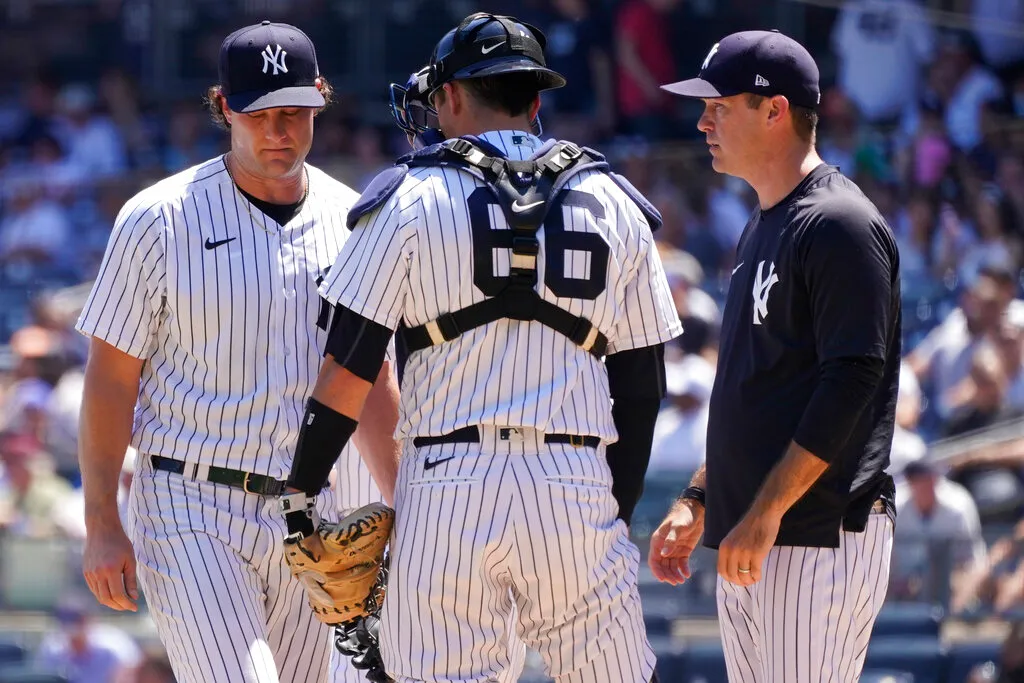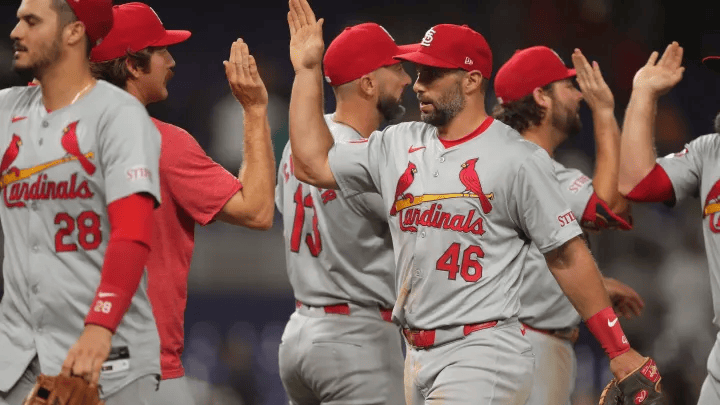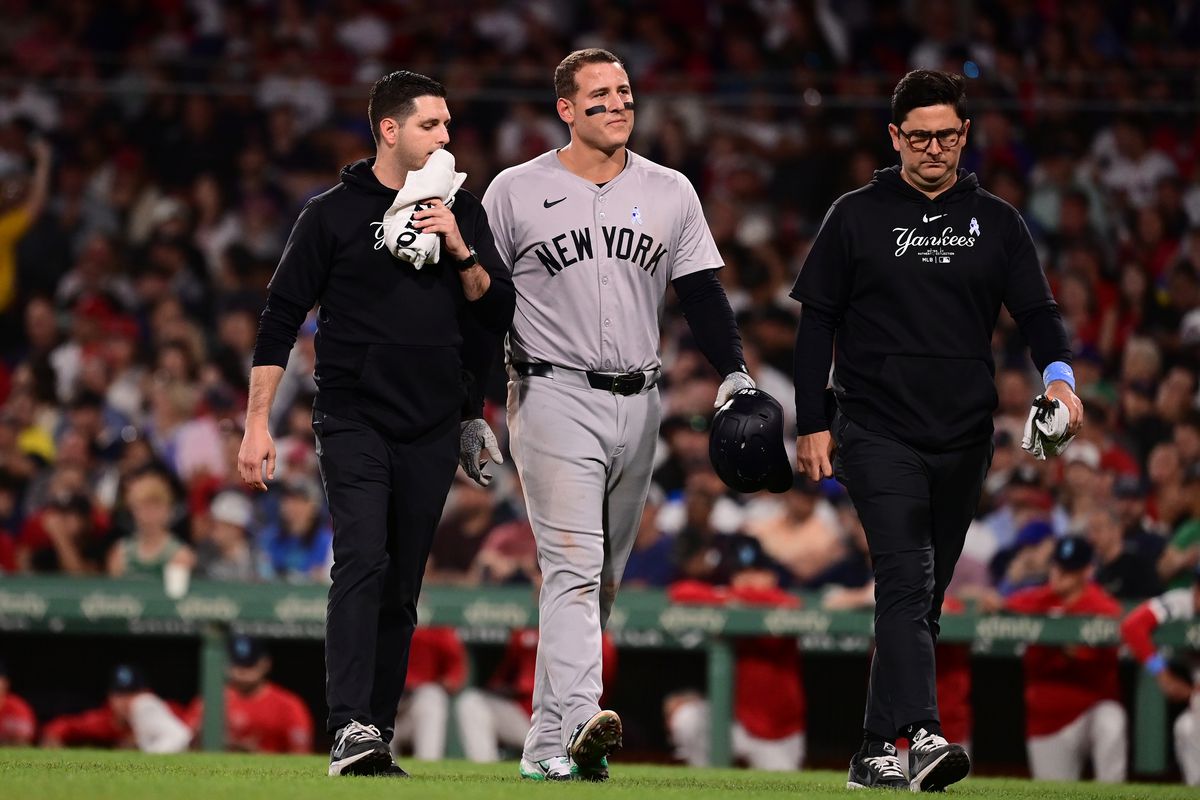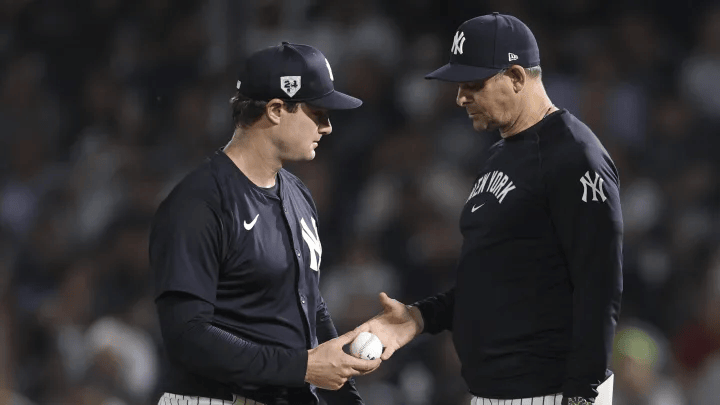How the Yankees can address three biggest roster concerns ahead of the MLB trade deadline.

We are around 70 games into the season, and the Yankees have the best record in baseball. However, it would be a mistake for general manager Brian Cashman to sit out next month’s trade deadline. After all, New York is in full-throttle mode, with high hopes of reaching the World Series after missing the playoffs entirely last season.
So, let’s look at three roster flaws that the Yankees should try to resolve before the trade deadline.
1. The right side of the infield
The Yankees have an Anthony Rizzo and Gleyber Torres issue. Nobody, not even FanGraphs’ reliable ZiPS prediction system, expected these two teammates to do so poorly. The Yankees’ right side of the infield is tied for 26th in extra-base hits (31), 23rd in RBIs (51), 23rd in slugging (.339), 24th in average exit velocity (87.3 mph), and 21st in batting average with runners in scoring position (.226).
Torres’ 86 OPS+ is the lowest of his career, with poor performance coming in his walk year, no less. This season, the 27-year-old has performed better on the road (112 wRC+) than at home (66 wRC+), supporting the belief that he may succeed outside of New York. While many have remarked that Torres’ mental mistakes on the field have reappeared, his 0 DRS is an improvement over last year’s -4 DRS at the position. Oswald Peraza, long thought to be Torres’ heir, has struggled in Triple-A this season.
The Yankees could trade Torres for prospects, then trade those prospects for guys like Padres infielder Ha-Seong Kim or Reds second baseman Jonathan India. Regardless of what the Yankees do with Torres, whose name is frequently mentioned in trade rumors, the second baseman’s limited offensive performance will cost him millions in his next contract, regardless of whether he is sold before August.
Though Rizzo’s stats were not forecast to be significantly higher than those of a league-average hitter, he was expected to have a positive WAR. Instead, his 34th season has been a fiasco.
There are 22 qualified first basemen in the MLB with higher fWARs than Rizzo (-0.5). Only two players in the American League have had worse offensive seasons: Nolan Schanuel of the Angels and Spencer Torkelson of the Tigers, who has been sent to the minors. The Yankees’ 77 wRC+ at first base ranks 24th in the majors.
Rizzo has played all but four games at the position. What exactly can the Yankees do about it? His trade value has never been lower, and it’s unlikely that a change of location or clubhouse will address his hitting problems. Rizzo is a well-liked veteran and a valuable member of the Yankees’ clubhouse, and he had thrived in New York until his concussion-plagued 2023 year.
It makes sense for the Yankees to keep Rizzo, but use him less. DJ LeMahieu may move to first base, and the high-energy Oswaldo Cabrera can settle in when given consistent playing time at third base. Rizzo coming off the bench in a playoff game for a huge, pinch-hitting role would not be the worst option. After all, he won a championship with the Cubs in 2016, and he still has the potential to aid the team down the line.
2. Luis Gil’s workload

The right-handed rookie has provided a surprise boost to the Yankees’ rotation without Gerrit Cole. His 2.04 ERA is the fifth-best in MLB. His.136 batting average against is the lowest in the majors, and it helped him win AL Pitcher of the Month and Rookie of the Month in May at the age of 26. When he pitches, he has the best winning percentage in the American League (.889). His strikeout rate of 10.80 per nine ranks seventh in the majors. He’s been composed under pressure, fierce against top lineups, and is now in contention for the AL Cy Young Award. There’s really nothing not to enjoy about Gil, except his rising workload.
Gil’s arm has begun to wear down after 75 innings pitched. Manager Aaron Boone stated that in Gil’s most recent outing against the Dodgers on Sunday, the righty began to feel tired in the fifth. Though Gil is still a rookie, he made seven starts for the Yankees in 2021-22 before having Tommy John surgery. Gil has now surpassed his career high in big-league innings, which he set at the end of April. The Yankees don’t want to lose a stud from the rotation, but reducing his workload is the greatest short- and long-term choice for the team.
With Cole close to returning, the Yankees could move Gil to the bullpen, shortening his leash and saving his arm in the process. But it would cost New York its most effective starter to date, and he would no longer be stretched out if/when another starter goes on the injured list. They could give him what pitching coach Matt Blake called a “timeout,” but that scenario presents concerns of its own, particularly whether Gil could return to be just as effective after a break. There’s no telling how Gil would respond to either decision, but moving him to the bullpen is likely the safest bet to avoid injury while keeping him active.
The rest of the Yankees’ rotation is quietly in the same boat as Gil. Marcus Stroman has pitched 176 innings four times in his career, but Carlos Rodón has only reached it once (178 IP in 2022), and neither of the remaining healthy starters (Nestor Cortes or Clarke Schmidt) has. The Yankees’ staff just does not have enough workhorses to sustain this run when combined with a middle-of-the-road projected FIP.
Adding another top-tier starter at the deadline would surely lessen the dependence on Cole & Co. A reunion with a two-month rental like Luis Severino seems unlikely this soon after the Yankees let him walk. Swapping for young White Sox left-hander Garrett Crochet, who has two more years of team control remaining, would be a strong option, but he’s also dealing a career-high in innings pitched this season. Perhaps right-hander Jack Flaherty is the man for the moment, since he hits free agency in the offseason and the Tigers could be shaping up to be sellers.
3. The bullpen’s right-handed reliance
No, Clay Holmes’ entrance song isn’t the only problem in New York’s bullpen. At first appearance, the Yankee relief corps appears to be solid. The bullpen’s.313 ERA is third in MLB, while its.212 batting average against is fourth. The unit’s WHIP of 1.19 is tied for eighth. However, the bullpen has a strikeout percentage of only 22.0%, ranking 20th in the MLB. While the team’s lack of punchouts hasn’t damaged them yet, strikeouts will be a key in the playoffs. And, in October, the Yankees offense is unlikely to score as many runs or provide the same cushion to the bullpen while facing the top pitchers in the game on a daily basis.
So, taking a closer look, here are the Yankees pitchers’ runs allowed per game by inning, followed by MLB ranking.
1: 0.31 (3rd-best)
2: 0.26 (best)
3: 0.43 (9th-best)
4: 0.17 (2nd-best)
5: 0.31 (4th-best)
6: 0.39 (4th-best)
7: 0.51 (19th-best)
8: 0.37 (9th-best)
9: 0.33 (14th-best)
That much of a drop-off is difficult to ignore. The Yankees won’t be the only club looking for relief help over the next few weeks, but they can at least rely on southpaws. The Yankees now have only two left-handed bullpen options, and while Victor González (2.84 ERA) has performed admirably in low-leverage situations, Caleb Ferguson (4.71 ERA) has disappointed. The Yankees should target Marlins southpaw Tanner Scott, who isn’t getting enough save opportunities in Miami, and assign him to a setup role before handing the ball to Holmes. Adding Scott (1.30 ERA, 27.2 IP) to a bullpen that may also lose Gil or Schmidt to the rotation results in a more playoff-ready relief team.



Your article helped me a lot, is there any more related content? Thanks!